�
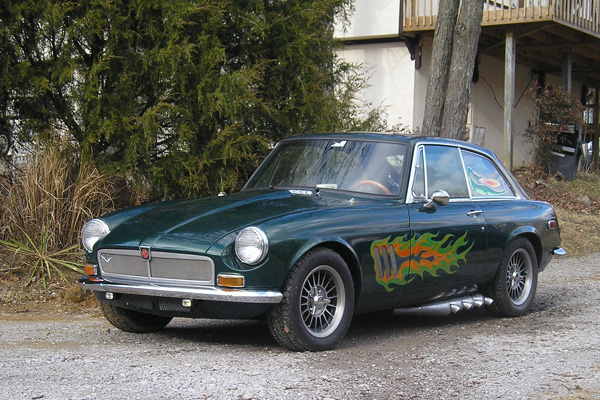
�
Howard Fitzcharles' 1970 MGB GT with Oldsmobile 215 V8
� � Owner: Howard Fitzcharles� City: Smyrna Tennessee
� Model: 1970 MGB GT
� Engine: Oldsmobile 215cid V8
� Conversion by: owner�
�
The Green Dragon
� �
My version of an MGB GT V-8 started when a friend who was a NASCAR builder and�
driver offered me a 215 Olds V-8 that he'd just hopped up and put in an Isuzu�
pickup truck as a street rod. He shortly pulled it out, claiming it was too small.�
He offered it to me at a very low price but I had not thought about putting a V-8�
in anything, so I declined the offer. The truck ran well but my motorcycle racing�
background told me that it was stopped up on the intake and the exhaust.�
�
A week later my son told me that the local Jaguar and Ferrari dealer was cleaning�
out their loft and had some good deals. I attended and purchased several Jaguar�
parts I had been wanting. I saw four Weber carburetors that came off of a Ferrari 308�
and I knew their value so I didn't make an offer even though I knew an Olds engine�
in bad need of them. The dealer's staff noticed me looking at the carburetors and made�
me an offer I couldn't refuse. I raced back to my friend's house and bought the�
Oldsmobile engine. Thus started my V-8 conversion. �
�
My son had used the MGB GT as an autocross car and for transportation. He wore it out and�
traded it to me for a Yamaha RD400 motorcycle. I did a ring and valve job on the MG and�
then drove it to and from work for 5 years. It was completely worn out and looking rough�
after that. Floorboards and rockers were rusted-out. Its new black�
hood was unpainted and its fiberglass front fenders were unpainted. Its dashboard�
was cut-up. It had no carpeting, one tan seat, and one black seat. The only thing�
it had going for it was a good set of Mag wheels and wide tires.�
�
I didn't think it was worth restoring, but I loved the car and couldn't even�
think about junking it. Now it suddenly had a new purpose. It would be the basis�
of a a V-8 conversion!�
�
That was over 10 years ago. As I started building, it became my hobby and I started doing�
things I'd always wanted to do since my days working in Jaguar and MG dealerships. I�
built a rotisserie and started correcting body damage, replacing floorpans, etc. By�
the time I finished with the rotisserie, I had acquired four more 215 V-8 engines.�
One of the Olds engines was not rebuildable so I�
stripped it down and used it for trial installations while making motor mounts, etc.�
I didn't like the way other MGB V-8 engine installations often extend over the steering�
rack, so I cut the firewall away and moved the engine rearward and down. This gave me�
more room for the Weber carburetors too. I designed my own intake manifolds and�
sandcast them.�
�
To reflect my motorcycle racing days, I wanted to install eight reverse-cone megaphones.�
My NASCAR friend advised me that was "old school". He said I could use "step headers"�
to make the same power. I told him my engine would put out all the power I could use anyhow,�
and the tone of the megaphones is the exact sound I wanted. �
�
I replaced the MG transmission with a Triumph TR-7 5-speed gearbox and a TR-8 clutch disk with a�
Mazda RX-7 Turbo pressure plate. I cut the Olds flywheel down to lighten it and had�
the pressure plate and flywheel balanced. Then I machined a Honda Civic front pulley to�
fit the crank and attached a trigger wheel to the back of it for the direct ignition system.�
After eliminating the distributor, I made a short shaft to drive the oil pump.�
The oil pan and oil pick-up needed to be shortened to make ground clearance for the oil�
pan. I modified the oil pump to facilitate using a remote oil filter.�
�
�
I removed the starter ring gear and starter motor and designed and built a distributor�
to direct inject compressed air into each combustion chamber. Rather then going into the�
head, I drilled through the cylinder walls just over the top piston ring. On some cylinders�
my holes broke into the coolant jacket so it was necessary to press in steel tubes to seal�
the compressed air circuit. �
�
I milled water pump mounting features off of the timing cover so I could mount the air�
distributor there instead. Then I fabricated a custom engage/disengage unit to connect�
the distributor to the camshaft. A cable control allows me to disengage the air distributor�
when the engine is running. However, it's necessary to re-engage the distributor just before�
shutting the engine down to resynchronize the distributor with the camshaft. If I forget�
to re-engage the distributor before shutdown, I can manually reset the timing with a knob�
mounted under hood.�
�
I needed a one way valve to prevent combustion pressure from blowing back into the�
pneumatic starting system. I couldn't find a suitable valve so I designed my own;�
but it took five attempts to build one that would work. However the air distributor�
itself - the most complicated part on the car - worked right the first time! No modification�
needed at all.�
�
The pneumatic starter system uses an onboard tank made from a Freon bottle.�
An electrically operated air compressor recharges the air tank.�
�
In lieu of a stock water pump, I installed a BMW water pump remotely. Coolant is plumbed�
all the way around the engine to fourteen ports in the engine block and cylinder heads. All�
four outlet ports on the cylinder heads are utilized. (GM's system only used the two front�
ports.) I blocked off the large transfer ports from block to heads and enlarged�
the so-called steam holes and made a few new holes between the block and heads. I fear that�
the engine will be too cool now, so I installed a Jaguar thermostat housing. I can control�
engine temperatures better with it. I also made a larger then normal water pump pulley to slow�
down the coolant. �
�
My Weber carbs didn't come to me with velocity stacks, so I used motorcycle�
trumpets. Even with the engine lowered, the stacks came too close to the hood, so�
I cut from the front all the way back to the rear cross bracing. I lifted the rear�
of this center section. I installed a sort of cowl induction vent at the rear of�
this reverse hood scoop.�
�
Because I cut the firewall back, I had to mount the accelerator pedal further back.�
I'm tall, so that made my right knee interfere with the shift lever. I had to make an�
offset lever to provide room for my knee. The clutch and brake pedals are moved to the�
left as is the steering column. This also required that I cut the MG steering rack�
shaft short and add two Moroso steering U-joints. �
�
I'd helped a friend who owned a bodyshop with his hot rod, and he offered to paint my GT�
in return. When I took the body to my friend, I looked through a book of color chips and�
picked a nice one. It was a metallic green used by Ford on pickup trucks. My friend�
shortly phoned me to say he was going to report me to the Bondo police. He had to remove�
the Bondo I'd smoothed on the car. He also said he wasn't going to paint my car the color�
I'd picked and I should come down and see his preferred color. I tried to explain it was�
my car, but he didn't want to hear it. Turns out, his color was much better! It's basically�
a pearl version of the color I'd initially chosen.�
�
Then I told him about the flames I was going to paint on the sides after he finished.�
He said I should let him do the flames too. I'd been wanting flames on the front fenders�
and had looked at flame designs for a long time. I drew some up on my PC and made a�
transparency to go on a projector. When he finished painting my car green, I took the�
projector and showed the flames I'd drawn. He said to just leave the projector and he'd�
match it exactly. �
�
The next problem was that the "show car" class paint job looked too good. Now I had to�
re-chrome my trim to match. I had to start polishing all sorts of parts and I even�
bought powder coat equipment to make ugly parts pretty. �
�
�
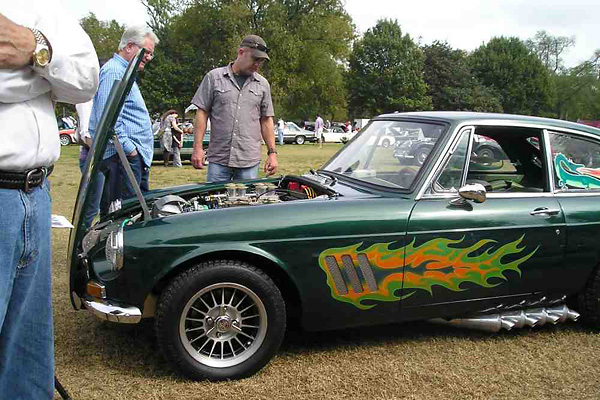
�
Front hinged bonnet, fender vents, and flames!
�
�
The car wasn't quite finished last year in time for our local British Car show, but I decided�
to show it anyway. I hauled it to the show on a trailer. There was no class for Frankenstein cars,�
so they put me in the same class as regular MGB's. I got a 3rd place award, which I was very�
pleased with because there were many pristine MGB's there from several states.�
I even fired it up at the show, which set off car alarms in a 10-mile radius. Ha!�
�
I still had running issues which I have been working on this year. It had so many that they�
were covering each other up. As I found each problem and corrected them, there was still a�
problem. For example, fuel supply: I had added racecar style safety foam through an access panel�
cut into the top of my fuel tank. I learned that the foam is so dense that fuel doesn't come�
out of it very fast, causing fuel starvation problems. Meanwhile, the fuel pump I was using�
couldn't pump the pressure required by the Weber carburetors. �
�
A Ferrari 308 puts out pretty good power for a 3 liter. I figured that my 3.5L engine would�
need similar jetting. The engine would only run on choke and as soon as the choke was "off"�
it cut off instantly. Weber jets are expensive so I went to the bank to get a loan to buy�
several sets of eight each. The bank said they never make loans that large, so the normal�
procedure of starting too rich and working my way toward lean was out. I purchased one set of�
jets and started drilling one bit size at a time until my engine would run off choke. One size�
more and I would have needed to drill out the passageways in the carburetors. Now, the engine�
would run at high RPM but not idle, so I started drilling out the idle jets too and got�
it to idle. But now if I revved the engine a couple of times it would die. Double checked the�
float levels and vents and finally looked at the float needle and seats and found that the needle�
seat hole was smaller then the size of the original main jets. I then drilled out the seats and�
re-seated the needles and checked to see that the fuel pressure didn't force the floats down. I�
drove the car around the yard a little but still noted a fuel pressure drop when revving the�
engine so I may need a different pump or two pumps. �
�
I've decided to name my car the "Green Dragon" but not for the reason one might think. I�
named it after the Green Dragon Tavern in Boston, MA. This is the tavern where the first plan�
was formulated to make a new country and rebel against the Crown. Most of these people were�
British and loved their home country, but they didn't like the way the Crown was treating them in�
this new land. I love British cars and bikes, but I wanted to make my car the way I wanted it.�
So I too rebelled. I put in an American V-8. I used many other brand car parts and even committed�
the sin of putting flames on a British car. My car is a Rebel of sorts and that's is why I have�
named it after the tavern where American colonists first rebelled against the Crown. I'm proud�
to fly both an American and British flag on my car. Some purists sneer, but it's as I want it.�
�
�
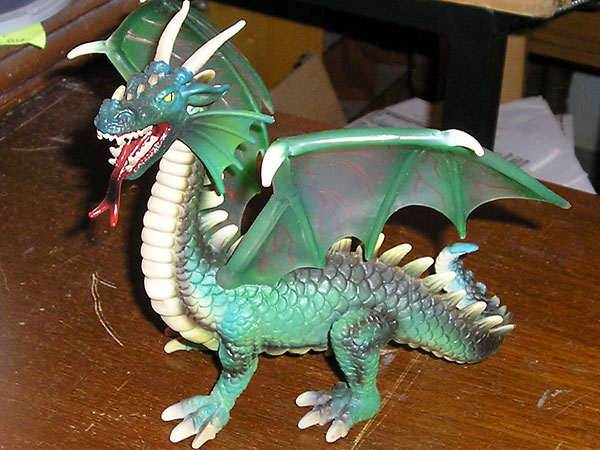
�
Green Dragon Mascot
�
Features and Specifications
�| Engine: | �Oldsmobile 215cid V8.�
Honda Civic front pulley, with trigger wheel for crank position sensor added.�
Offenhauser finned aluminum valve covers.�
Custom sand-cast intake manifolds.�
Four Weber DCNF 40mm carburetors.�
Electromotive XDI ignition system.�
Accel Super Stock 8mm spark plug wires.�
Custom shaft installed, to drive the oil pump.�
Remotely mounted oil filter.�
Custom pneumatic direct-injection starter system. | �
| Cooling: | �Summit Racing aluminum radiator (Sum-380324), modified ports.�
�
Belt-driven BMW "7 series" water pump, mounted to a piece of aluminum plate.�
Jaguar electric fan, pushing.�
MGB oil cooler. | �
| Exhaust: | �eight individual pipes into eight reverse-cone megaphone mufflers. | �
| Transmission: | �LT77 5-speed (from a Triumph TR-7). �
Triumph TR-8 clutch disk.�
Mazda RX-7 Turbo pressure plate.�
Olds flywheel, lightened.�
Pressure plate and flywheel balanced. | �
| Rear Axle: | �Ford 8.8 housing center section mated to MGB (Salisbury) tubes.�
Traction-Lok limited slip differential.�
3.03:1 gears.�
Ford axle shafts, resplined by Moser Engineering. | �
| Front Susp.: | �stock MGB shock absorbers.�
Polyurethane bushes.�
Oversized rebound stops.�
3/4" anti-sway bar on polyurethane bushings.�
Moroso steering universal joints (2). | �
| Rear Susp.: | �Leaf springs.�
Tube shocks (Nissan pickup).�
Polyurethane bushes.�
Torque arm and coilover shock to stop wheel hop. | �
| Brakes: | �(master) stock tandem master cylinder. � (front) Wilwood four piston calipers. Toyota van vented rotors. � (rear) U.S. Brake calipers. Ford Crown Victoria rotors. | �
| Wheels/Tires: | �vintage magnesium wheels (marked "England").�
14" Remington tires. | �
| Electrical: | �Nippondenso alternator.�
Single 12 Volt battery. | �
| Instruments: | �Triumph TR-7 instrument cluster plus five additional gauges.�
(i.e. manifold vacuum,�
fuel pressure,�
oil pressure,�
oil temperature, and�
pressure in the air starter tank.)�
MSD knock sensor (LED) display.�
| �
| Interior: | �custom wood veneer dashboard.�
13.5" steering wheel.�
Triumph TR-7 seats with headrests removed.�
Custom upholstery and carpet throughout. | �
| Body: | �custom aluminum and stainless steel mesh grille.�
Bumper overriders removed.�
Fiberglass front fenders.�
Front fender vents (behind the wheels.)�
Custom front and rear fender flares.�
Front-hinged bonnet with cowl-induction scoop.�
LED license plate lamps.�
Custom badges.�
| �
| Paint: | �dark green pearl... | �
Engine Installation
��
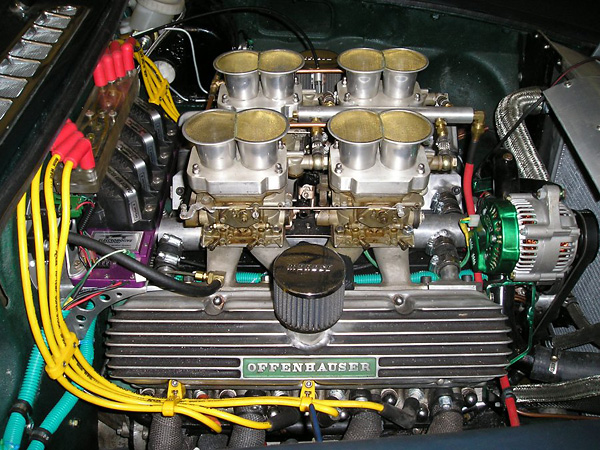
�
Oldsmobile 215cid V8 with four Weber DCNF 40mm carburetors and Offenhauser valve covers.
�
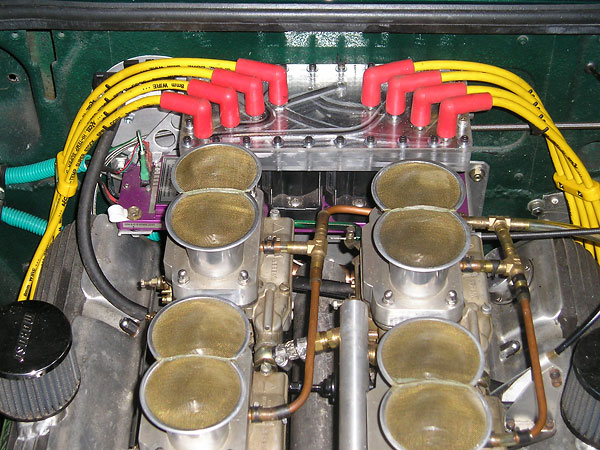
�
Electromotive XDI ignition system.
�
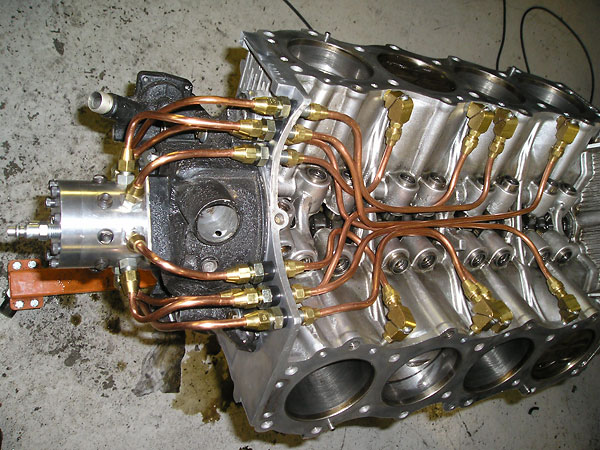
�
Plumbing for direct-acting pneumatic starting system. Howard commented:
�
"With its air starter, my car sounds like an old tractor when turning over on
�
compressed air alone. When I first got the system installed, I was surprised
�
by loud "pops" of compressed air and I was worried I was losing pressure
�
due to an early valve opening in the air distributor. However, I found it was
�
an issue with my camshaft. The exhaust valves were opening way too early
�
before bottom dead center; I was using 100 degrees of power, starting at
�
about 10 degrees After Top Dead Center and closing at about 110 ATDC."
�
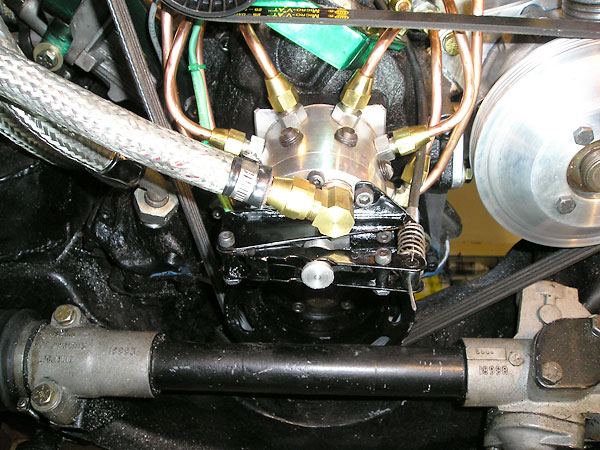
�
Center: air distributor for the pneumatic starting system is cable actuated.
�
Right: BMW 7 series water pump mounted to a custom fabricated plate and
�
driven through a oversized hand-made aluminum pulley.
�
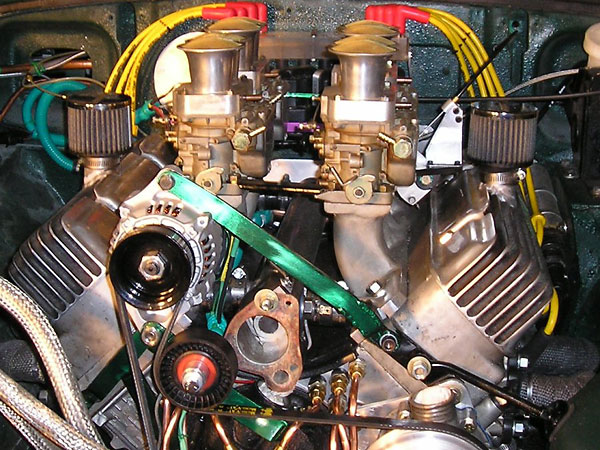
�
Custom sand-cast intake manifolds.
�
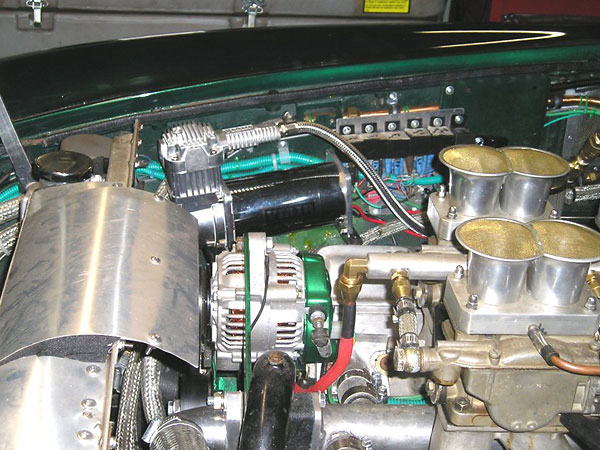
�
Electric air compressor. Nippondenso alternator.
�
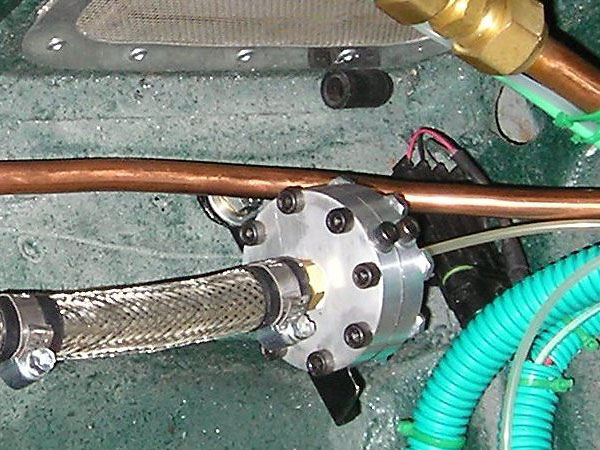
�
Howard's custom fuel gauge "transducer" has a rubber diaphragm inside to separate
�
gasoline from silicone oil. The oil side is plumbed to a dashboard mounted fuel
�
pressure gauge. (No flammable liquid in the cockpit!)
�
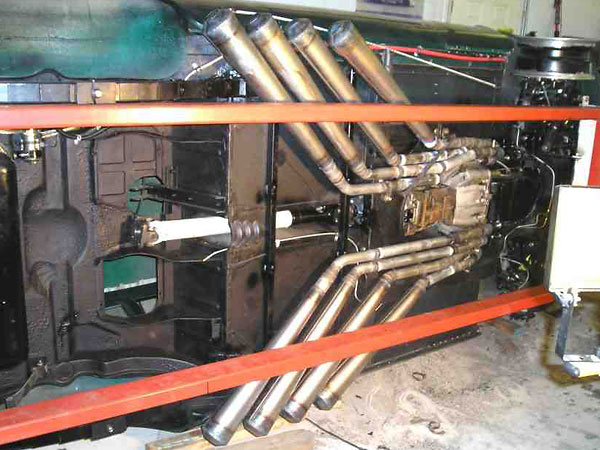
�
Eight individual pipes into eight reverse-cone megaphone mufflers.
�
| �
Enjoying this article? Our magazine is funded through the generous support of readers like you! � To contribute to our operating budget, please click here and follow the instructions. � (Suggested contribution is twenty bucks per year. Feel free to give more!)� |
Suspension
��
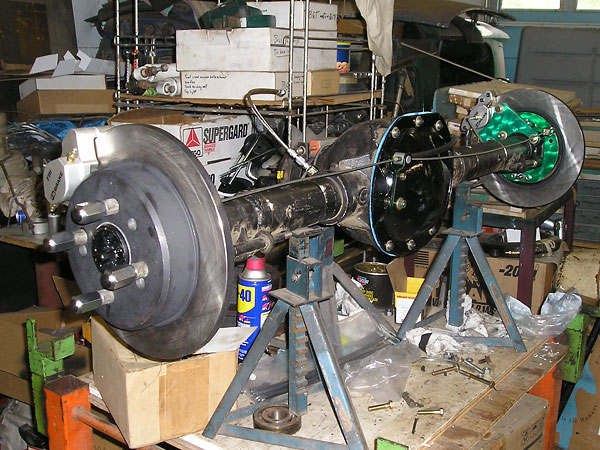
�
Hybred Ford 8.8 / MGB (Salisbury) axle, upgraded with disk brakes. Not shown:
�
"Even though so called Traction Bars stop wheel tramp, I opted for the 'Dirt
�
Car' system of a torque arm and a coil over shock to cut down on wheel hop."
�
�
Interior
��
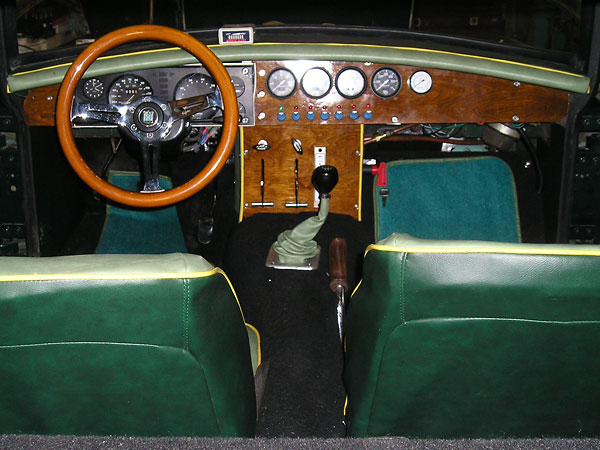
�
"I used a Triumph TR-7 instrument cluster from a five-speed equipped car so the
�
speedometer would be close to correct." Additional gauges for manifold vacuum,
�
fuel pressure, oil pressure, oil temperature, and pressure in the air starter tank.
�
Foreground: "I like how light MG seats are compared to Triumph TR-7 seats, but
�
TR-7 seats keep you in the seat when driving hard and the MG seats don't."
�
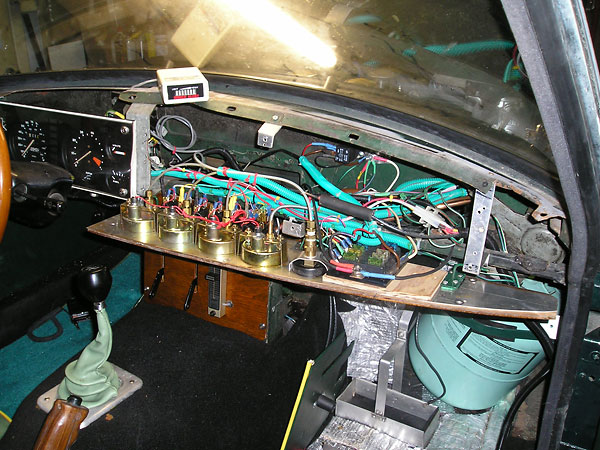
�
Easy access to wiring behind the custom dashboard. An LED display atop the dashboard
�
eyebrow is connected to an MSD knock sensor, and a slider control in the center
�
console is for making ignition advance adjustments on the fly. A pressure
�
tank in the passenger-side footwell stores air for starting the engine.
�
Exterior
��
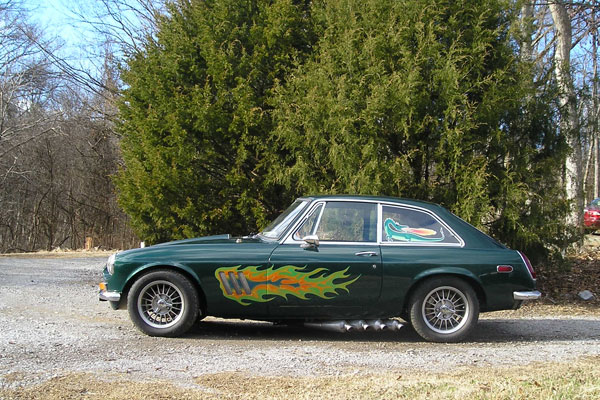
�
These vintage magnesium wheels were made in England,
�
but the specific manufacturer is unknown.
�
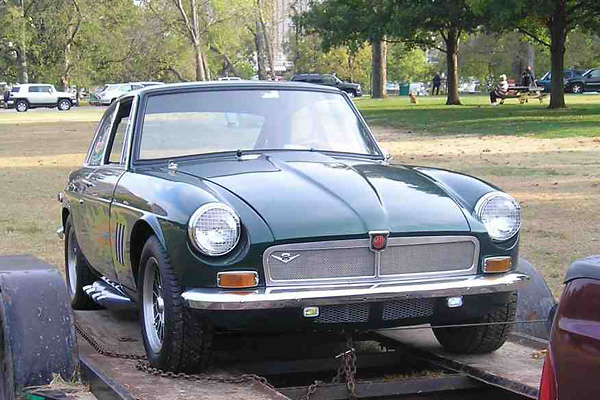
�
Custom aluminum and stainless steel mesh grille. Modified hood with raised center.
�
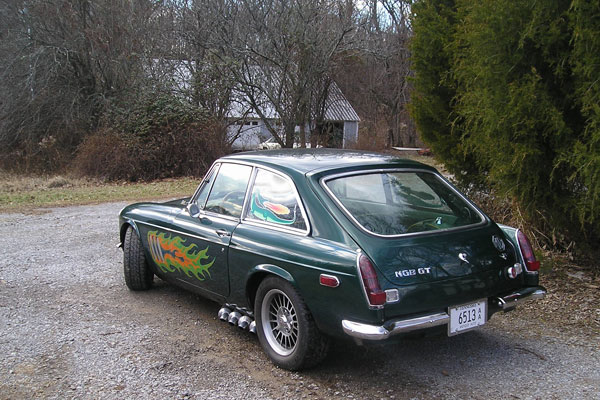
�
Tasteful fender flares. Four muffler tips per side.
�
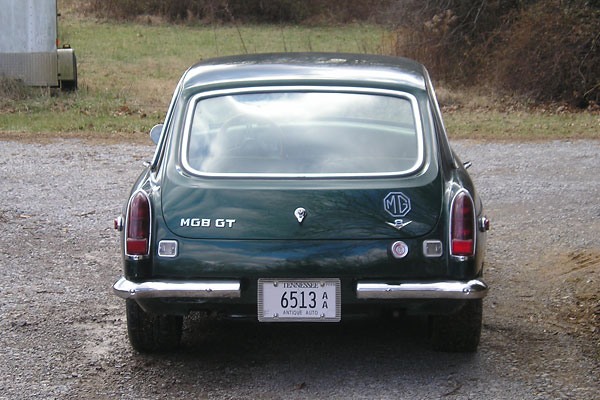
�
"Split" rear bumpers are exclusive to 1970-model-year North American market MGBs,
�
and they haven't been available in the aftermarket for many, many years.
�
� All photos by Howard Fitzcharles for BritishV8's exclusive use. Copyright 2014. All rights reserved. �
� �
